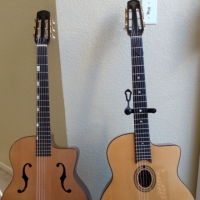DjangoBooks.com
Welcome to our Community!
Categories
- 20K All Categories
- 1.1K General
- 475 Welcome
- 59 Archtop Eddy's Corner
- 146 CD, DVD, and Concert Reviews
- 383 FAQ
- 26 Gypsy Jazz Italia
- 25 Photos
- 202 Gypsy Picking
- 21 Unaccompanied Django
- 15 Pearl Django Play-Along Vol.1
- 17 Gypsy Fire
- 45 Gypsy Rhythm
- 1.4K Gypsy Jazz University - Get Educated
- 130 Gypsy Jazz 101
- 223 Repertoire
- 218 History
- 707 Technique
- 51 Licks and Patterns
- 6 Daniel Givone Manouche Guitare Method Users Group
- 20 Eddie Lang Club
- 1.3K Gypsy Jazz Gear
- 800 Guitars, Strings, Picks, Amps, Pickups and Other Accessories
- 457 Classifieds
- 49 Recording
- 62 Other Instruments
- 18 Violin
- 5 Mandolin
- 22 Accordion
- 7 Bass
- 10 Woodwinds
- 345 Gypsy Jazz Events
- 141 North America
- 109 Europe
- 95 International












Comments
It rubs right off.
Something seems to have happened to a response that I though I has posted a few days ago. Anyway, I recall reading somewhere (sorry, don't remember where) that the 10th fret was picked to appeal to the many jazz banjo players who were switching to guitar in the 30s.
The 9th fret on American guitars had nothing to do with note locations, it was simply selected because it appears to be symmetrical visually. The initial fret marker is usually at the 3rd fret from the nut (or zero fret), so they placed the next ones at 5, 7, and then 9 because it is three frets from 12.
I made the switch to 10 after Michael Horowitz advised me against moving the dot on a Dupont, because he felt it would devalue it. It is true that you can move it back if so desired, but it is still evident that there has been a modification. If you never plan to sell your guitar, then it's no big deal. Now I love it at 10, and since most of my playing is on my GJ guitar, I just put up with the 9th fret when I switch to another guitar.
"It's a great feeling to be dealing with material which is better than yourself, that you know you can never live up to."
-- Orson Welles
The fact is that dot placement has little to do with referencing certain notes on the 5th and 6th strings. It is a random placement for esthetic purposes. Arguing that one or the other is better for all is the province of a fool. Each can be adapted to and works just fine. Lesser players will be challenged when playing an instrument that is different than their own.
In the 10 years that I have been involved with this forum, I have read some far fetched ideas. Comparing 9th fret dot placement with burning witches may be the farthest fetched idea yet. 8-|
Cheers, Marc
www.hotclubpacific.com
"It's a great feeling to be dealing with material which is better than yourself, that you know you can never live up to."
-- Orson Welles
Maybe lost to history, the dots are references for the Fibonacci series, which when harmonics are considered, give a pure major chord with octave and perfect fifth redundancies. The dot at the 9th fret marks 2/5ths the string length. The harmonic there is of the 5th partial (the major third) -- this is the one that throws you off.
This is my observation, and it is so easy once seen, that I have little doubt that many people have stumbled across it. Nonetheless, Gibson and Martin guitars had nothing to say about it, and so far as I could see, nothing to see in google searches. THE DOTS MARK THE HARMONICS COMPRISING A PURE MAJOR CHORD.
Are the dots an atavism from pre-equal tempered tuning? In historical paintings of fretted instruments, or in museums, when are the earliest dots seen in their modern location??
string
open = 1 = do
dots
12 = 2nd partial = do (octave over root)
7 = 3rd partial = sol (perfect 5th + octave over root)
5 = 4th partial = do (double octave over root)
9 = 5th partial = mi (double octave + major third over root)
3 = 6th partial = sol (double octave + perfect 5th over root)
I like it...
Nothing like
a little Cosmic Explanation to enlighten us.
Gonna smoke another beer and contemplate that one a little.
I'm Serious...
Edgar Degas: "Only when he no longer knows what he is doing does the painter do good things.... To draw, you must close your eyes and sing."
Georges Braque: "In art there is only one thing that counts: the bit that can’t be explained."
And tonight it's %&#$ing SNOWING AGAIN!!!!!
"It's a great feeling to be dealing with material which is better than yourself, that you know you can never live up to."
-- Orson Welles
(And I feel your pain, Klaatu... I grew up in Saskatchewan and lived in St. John's NL for two years.)